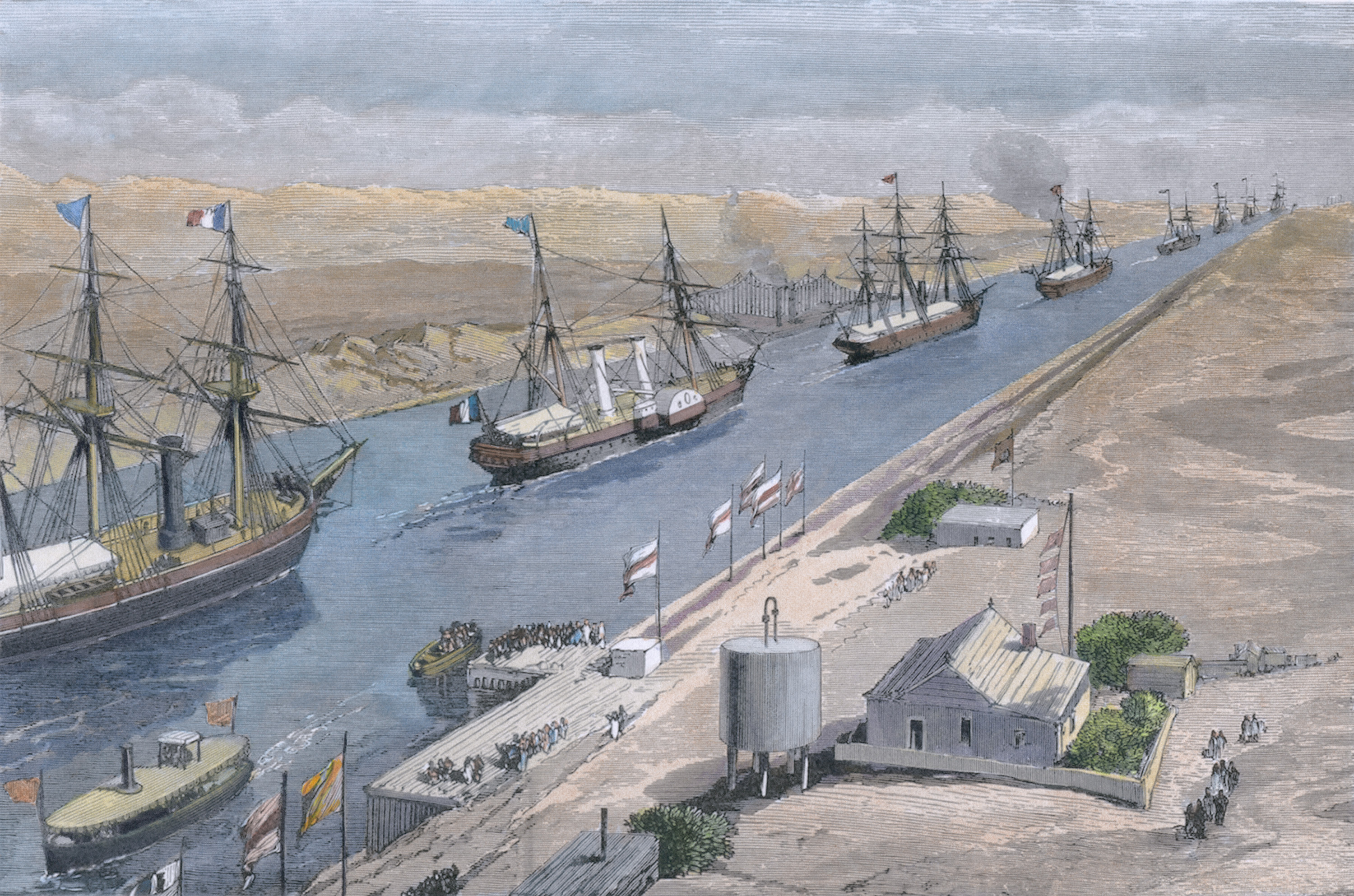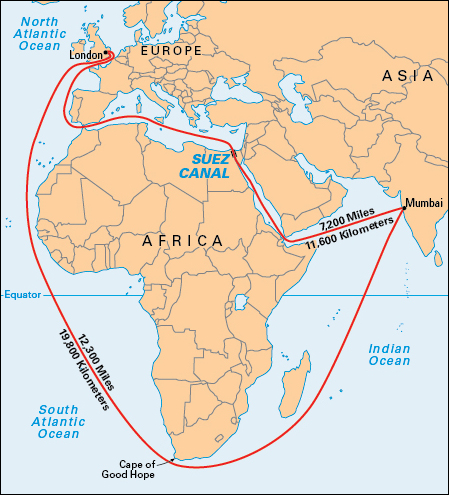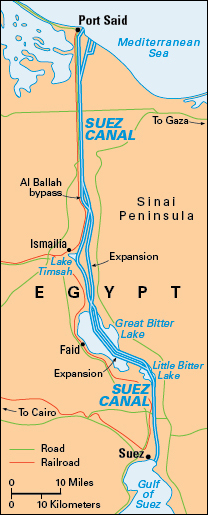Suez << soo EHZ >> Canal is a narrow, artificial waterway in Egypt that joins the Mediterranean and Red seas. Including its entrance canals, the Suez Canal extends about 120 miles (195 kilometers). The main canal is almost 100 miles (160 kilometers) long. When it opened in 1869, the Suez Canal reduced the shipping route between the United Kingdom and India by nearly half. The canal is one of the busiest interoceanic (between oceans) waterways in the world.

Description.
The Suez Canal stretches north and south across the Isthmus of Suez, between the cities of Port Said and Suez. It has no canal locks (chambers that enable ships to move from one water level to another) because there is no great difference between the levels of the Red and Mediterranean seas. Most of the canal can handle only single-lane traffic. When the canal was built, it measured 26 feet (8 meters) deep, 72 feet (22 meters) wide at the bottom, and about 230 feet (70 meters) wide at the surface. It has since been enlarged several times. In the early 2010’s, its minimum depth was 66 feet (20 meters) and its narrowest section was 741 feet (226 meters) wide at the surface. 
History.
In the times of the pharaohs, Egyptians built canals to connect the Nile River and the Red Sea. For a time in the A.D. 600’s, the Red and Mediterranean seas were joined by a canal. In 1798, when Napoleon I invaded Egypt, he saw advantages of building a waterway across the Isthmus of Suez. The British opposed the project and proposed their own railroad line from Cairo to Suez as an alternative.

In 1854, the French diplomat and engineer Ferdinand de Lesseps—a friend of Said Pasha, Egypt’s ruler—obtained permission to build the Suez Canal. By 1858, the Suez Canal Company had been organized with a capital stock of about $40 million. However, the terms of the agreement were unfavorable toward Egypt. Small investors in France purchased just over half the stock, but the stock sold poorly elsewhere. Egypt had to buy up the unsold shares, as well as supply much of the labor and labor costs. Construction on the canal, with Egyptian workers and equipment, began on April 25, 1859. Many Egyptian workers lost their lives during construction. The canal officially opened on Nov. 17, 1869. The Suez Canal Company was given a concession to operate the canal until 1968.
The unfavorable terms of the agreement, combined with Egypt’s large debt, forced the country to sell its shares in the canal in 1875. The United Kingdom purchased the shares. After that, a commission composed mostly of British and French members directed the management of the canal. The United Kingdom occupied Egypt in 1882, mostly to protect its investment in the canal.
In 1888, an international convention agreed that the canal should be open to all nations in peace and in war. However, the United Kingdom kept nations at war with it from using the canal during World War I (1914-1918) and World War II (1939-1945). In 1922, Egypt gained independence from the United Kingdom, though the British kept many powers. A 1936 treaty restricted British troops to the canal zone. In 1950, as a result of the Arab-Israeli war of 1948 and 1949, Egypt banned Israeli ships from the canal.
Under the terms of a 1954 agreement with Egypt, British troops left the canal zone in June 1956. In July, the United States and the United Kingdom withdrew offers they had made to help finance the Aswan High Dam across the Nile River. This and other factors, including a strong Egyptian nationalist movement, led to the take-over of the canal by Egyptian President Gamal Abdel Nasser on July 26. He said Egypt would use the canal tolls to build the dam. The United Kingdom, France, and other Western nations protested the take-over.
In October, the United Kingdom and France plotted with Israel to overthrow Nasser and regain control of the canal. On October 29, Israel invaded Egypt. The United Kingdom and France began air strikes against Egypt on October 31. They claimed military action was necessary to restore order to the region. However, the United States, the Soviet Union, and many other countries condemned the invasion. The United Nations arranged a cease-fire and sent a peacekeeping force called the United Nations Emergency Force (UNEF) to guard the borders between Egypt and Israel. The British, French, and Israeli forces soon withdrew from the region. In March 1957, the Suez Canal reopened under Egyptian management.
During the Arab-Israeli war of 1967, the Suez Canal became blocked by sunken ships. Egypt did not reopen the canal until June 1975. In 1979, Egypt ended its official ban against the use of the canal by Israeli ships. In 1980, a tunnel for motor vehicles was completed under the canal, 10 miles (16 kilometers) north of the city of Suez. In 2015, Egypt deepened and widened part of the existing canal and created a 22-mile (35-kilometer) parallel channel along part of the waterway.
